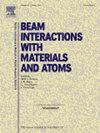Cellular uptake of gold nanoparticles in glioblastoma cells revealed by μ-PIXE
IF 1.4
3区 物理与天体物理
Q3 INSTRUMENTS & INSTRUMENTATION
Nuclear Instruments & Methods in Physics Research Section B-beam Interactions With Materials and Atoms
Pub Date : 2025-01-06
DOI:10.1016/j.nimb.2024.165607
引用次数: 0
Abstract
The use of NPs has increased massively in numerous fields, including environmental sciences, electronics, and medicine. Because of their unique physical, optical, and biological capabilities, gold nanoparticles (AuNPs) are of considerable interest. These nanoparticles have distinct properties that make them useful as nanoprobes for imaging and nanocarriers for efficient drug delivery systems, for example. To harness their full potential in the biomedical area, it is crucial to accurately characterize their size, shape, and biological activity. In this study, the -PIXE technique has been employed to investigate the cellular uptake of these nanoparticles upon interaction with the U87 glioblastoma cell line. This analysis provided information on the internalization and distribution of nanoparticles within the cellular environment. To evaluate the cytotoxic effects of the AuNPs, the MTT assay was performed. This widely used method allows for the assessment of cell viability in the presence of nanoparticles. Lastly, their size was also measured by scanning electron microscopy, yielding a mean diameter of 18 ± 5 nm, which agreed well with previous MEIS results.
胶体母细胞瘤细胞对金纳米颗粒的摄取
NPs在包括环境科学、电子和医学在内的许多领域的使用都在大量增加。由于其独特的物理、光学和生物性能,金纳米颗粒(AuNPs)引起了相当大的兴趣。例如,这些纳米颗粒具有独特的特性,使它们可以用作成像的纳米探针和有效药物输送系统的纳米载体。为了充分利用它们在生物医学领域的潜力,准确表征它们的大小、形状和生物活性是至关重要的。在这项研究中,μ-PIXE技术被用来研究这些纳米粒子与U87胶质母细胞瘤细胞系相互作用时的细胞摄取。该分析提供了纳米颗粒在细胞环境内内化和分布的信息。为了评估AuNPs的细胞毒性作用,进行了MTT试验。这种广泛使用的方法允许在纳米颗粒存在的情况下评估细胞活力。最后,通过扫描电子显微镜测量了它们的大小,得到的平均直径为18±5 nm,与先前的MEIS结果吻合得很好。
本文章由计算机程序翻译,如有差异,请以英文原文为准。
求助全文
约1分钟内获得全文
求助全文
来源期刊
CiteScore
2.80
自引率
7.70%
发文量
231
审稿时长
1.9 months
期刊介绍:
Section B of Nuclear Instruments and Methods in Physics Research covers all aspects of the interaction of energetic beams with atoms, molecules and aggregate forms of matter. This includes ion beam analysis and ion beam modification of materials as well as basic data of importance for these studies. Topics of general interest include: atomic collisions in solids, particle channelling, all aspects of collision cascades, the modification of materials by energetic beams, ion implantation, irradiation - induced changes in materials, the physics and chemistry of beam interactions and the analysis of materials by all forms of energetic radiation. Modification by ion, laser and electron beams for the study of electronic materials, metals, ceramics, insulators, polymers and other important and new materials systems are included. Related studies, such as the application of ion beam analysis to biological, archaeological and geological samples as well as applications to solve problems in planetary science are also welcome. Energetic beams of interest include atomic and molecular ions, neutrons, positrons and muons, plasmas directed at surfaces, electron and photon beams, including laser treated surfaces and studies of solids by photon radiation from rotating anodes, synchrotrons, etc. In addition, the interaction between various forms of radiation and radiation-induced deposition processes are relevant.

 求助内容:
求助内容: 应助结果提醒方式:
应助结果提醒方式:


